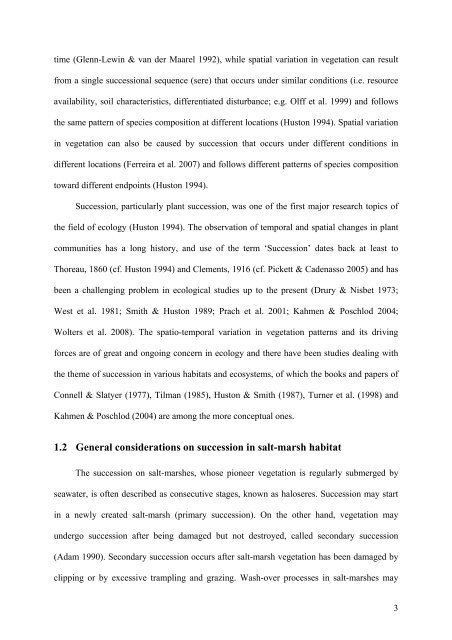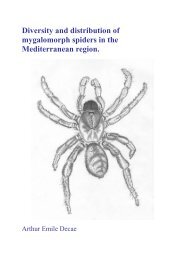PhD Reza Erfanzadeh 2009 - Ghent Ecology - Universiteit Gent
PhD Reza Erfanzadeh 2009 - Ghent Ecology - Universiteit Gent
PhD Reza Erfanzadeh 2009 - Ghent Ecology - Universiteit Gent
Create successful ePaper yourself
Turn your PDF publications into a flip-book with our unique Google optimized e-Paper software.
time (Glenn-Lewin & van der Maarel 1992), while spatial variation in vegetation can result<br />
from a single successional sequence (sere) that occurs under similar conditions (i.e. resource<br />
availability, soil characteristics, differentiated disturbance; e.g. Olff et al. 1999) and follows<br />
the same pattern of species composition at different locations (Huston 1994). Spatial variation<br />
in vegetation can also be caused by succession that occurs under different conditions in<br />
different locations (Ferreira et al. 2007) and follows different patterns of species composition<br />
toward different endpoints (Huston 1994).<br />
Succession, particularly plant succession, was one of the first major research topics of<br />
the field of ecology (Huston 1994). The observation of temporal and spatial changes in plant<br />
communities has a long history, and use of the term ‘Succession’ dates back at least to<br />
Thoreau, 1860 (cf. Huston 1994) and Clements, 1916 (cf. Pickett & Cadenasso 2005) and has<br />
been a challenging problem in ecological studies up to the present (Drury & Nisbet 1973;<br />
West et al. 1981; Smith & Huston 1989; Prach et al. 2001; Kahmen & Poschlod 2004;<br />
Wolters et al. 2008). The spatio-temporal variation in vegetation patterns and its driving<br />
forces are of great and ongoing concern in ecology and there have been studies dealing with<br />
the theme of succession in various habitats and ecosystems, of which the books and papers of<br />
Connell & Slatyer (1977), Tilman (1985), Huston & Smith (1987), Turner et al. (1998) and<br />
Kahmen & Poschlod (2004) are among the more conceptual ones.<br />
1.2 General considerations on succession in salt-marsh habitat<br />
The succession on salt-marshes, whose pioneer vegetation is regularly submerged by<br />
seawater, is often described as consecutive stages, known as haloseres. Succession may start<br />
in a newly created salt-marsh (primary succession). On the other hand, vegetation may<br />
undergo succession after being damaged but not destroyed, called secondary succession<br />
(Adam 1990). Secondary succession occurs after salt-marsh vegetation has been damaged by<br />
clipping or by excessive trampling and grazing. Wash-over processes in salt-marshes may<br />
3










